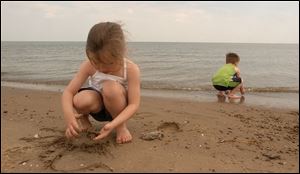
Heat sparks search for E. coli
6/12/2002
Breanna Chaffin, 4, plays in the sand while Zach Murphy, 2, hunts for stones and shells along the beach in Port Clinton.
PORT CLINTON - While sun revelers lounged at the city beach yesterday, state officials collected Lake Erie water samples to make sure it was safe to go swimming.
In its third day of testing, the Ohio Department of Health was looking for high levels of E. coli bacteria in the water at one of Lake Erie's most popular beaches. The tests, which will run through Aug. 29, will be used to warn swimmers of potential problems.
As the temperatures climb, so does the possibility of beach-goers encountering signs warning them to avoid contact with the water. “Usually, the beginning samples are fine, but a lot has to do with the temp of the water,” said Steve Binns, program administrator at the Ohio Department of Health. “We've noticed over the years that as the water warms up, so does the bacteria count.”
The state health department began testing area beaches for bacteria in the mid-1970s. The department tests 22 selected beaches along the Lake Erie shoreline from Lucas County to Ashtabula County.
In Lucas County, testing is being done both inland and on the lake in Maumee Bay State Park, as well as in Crane Creek.
Ottawa County sites include Camp Perry, Port Clinton City Beach, Catawba Island State Park, South Bass Island State Park, East Harbor State Park, Kelleys Island, and Lakeside.
The tests examine the levels of E. coli bacteria, an organism that can cause diarrhea and abdominal pain. Mr. Binns said E. coli is tracked because it is considered an indicator for possible fecal contamination of the water.
Hot weather helps increase the E. coli count. So do sewage and fecal material from birds that hover near beaches.
Water samples are taken from the sites four times a week, and the results are posted on the state health department's Web site. Once high levels of the bacteria are discovered, the state alerts the local health departments, which post warnings.
“Most people want to know, `Is it safe to go into the water? Yes or no?' But it's not a yes or no answer,” Mr. Binns said. “Research shows that the risk of getting sick increases when the levels of bacteria go up, but that doesn't mean everybody will.”
Despite research showing that not everyone will become ill after having contact with bacteria-infested water, beaches tend to lose a lot of business when warnings are posted. Port Clinton Parks and Recreation Director Ken Gipe said he notices some out-of-town guests tend to stay away from the city beach during posted warning periods.
Residents tend to be more in tune with the weather conditions that affect the bacteria levels, he said.
“We see some drop off of out-of-town users, I think, those who are just in for the week or weekend and see the posting,” Mr. Gipe said. “I think the more regular users don't really pay a lot of attention to the warnings.”
And although tourists avoid the beach during times of high bacteria levels, the warnings don't affect boaters, water skiers, and anglers - the majority of Port Clinton tourists.
“While we have a very nice beach, I think that's an added attraction,” Mr. Gipe said. “I think while warnings may affect tourism somewhat, I don't think the beach is the biggest attraction to the community.”
Similar tests are run on the Michigan side of Lake Erie. The environmental health division of the Monroe County Health Department said it began testing four sites on May 1.
To date, water from Estral Beach, Detroit Beach, Toledo Beach, and Luna Pier Beach have tested below the state standards of 130 colonies of E. coli per 100 milliliters of water.
The beaches at Sterling State Park have not yet been tested because the park is closed because of construction, added Carol Austerberry, director of the environmental health division.
“Lake Erie has been fine,” she said. “To the best of my recollection, we haven't had any closures in the past few years.”
Currently, metro Detroit's only beach showing high levels of bacteria is Memorial Park on Lake St. Clair in Macomb County.
Ken Silfven of the Michigan Department of Environmental Quality said some summers will be worse than others, especially hot and wet summers, which usually mean higher bacteria counts.
Overall, however, the state has shown improvement in surface water quality over the past few years, he said.
“I think the record shows that the closings are dwindling over the last two years, and that's a positive trend,” said Mr. Silfven, whose department posts the water tests on the Internet. “We are doing things that affect water quality, which will eventually lead to better beaches.”